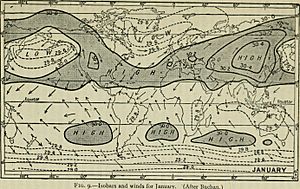Regional geography facts for kids
Regional geography is a big part of geography. It looks at how different natural things (like mountains or rivers) and human things (like cultures or cities) work together in a specific place. Think of it like studying a puzzle where all the pieces fit together in one area. Its partner, systematic geography, focuses on just one type of natural or human thing across the whole world.
Contents
What is Regional Geography?
Regional geography pays close attention to what makes a certain area special. This includes its natural features, the people living there, and how we divide space into different regions.
This idea started in German-speaking countries. It has two main parts:
- Studying unique places, like specific countries or continents. This is like learning all about one particular house.
- Studying types of landscapes, like coastal areas, mountains, or border regions. This is like learning about all houses that have a certain style.
How Geographers Study Regions
Regional geography is also a way of studying the world, similar to other methods like using lots of numbers (quantitative geography) or looking at how power affects places (critical geography).
This way of thinking was very popular from the late 1800s to the mid-1900s. It was the main way geographers studied things back then. However, some people later criticized it. They said it was too focused on just describing places and didn't have enough strong theories. This criticism became strong in the 1950s.
Even with the criticism, regional geography has influenced many other areas of geography, like how we study economies (economic geography) and landforms (geomorphology). Many universities still teach regional geography today to help students learn about the main regions of the world.
For example, in North and South America, we might look at cultural regions (like North America and Latin America) or geographic regions (the continents themselves). These areas don't always have the same borders! In Europe and Asia, it's similar. These differences happen because there isn't one perfect way to define and draw the lines for these regions.
Since the 1980s, geographers have also started looking at "city-regions." This means studying how cities and the countryside around them interact. Some geographers have also tried to bring back more regional studies, looking at how regions are defined in complex ways and how they connect with different scales (like local, national, or global).
Regional geography was once used to help understand landforms, for example, by geographers like David Linton. However, since the 1990s, most experts don't use regional geography as the main way to study landforms anymore.
Famous Regional Geographers
Many important people helped shape regional geography:
- Alfred Hettner from Germany, who came up with the idea of chorology, which is about studying areas.
- Paul Vidal de la Blache from France, who developed the idea of possibilism. This idea suggests that the environment offers possibilities for how people live, but it doesn't completely decide their way of life. It's a softer idea than "environmental determinism," which says the environment completely controls how people live.
- Richard Hartshorne from the United States, who focused on "areal differentiation," meaning how different areas are unique.
The ideas of Carl O. Sauer were also strongly influenced by Alfred Hettner and Paul Vidal de la Blache. His work is also considered a part of regional geography.
See also
 In Spanish: Geografía regional para niños
In Spanish: Geografía regional para niños
- Chorography
- Regional planning
- Regional studies


